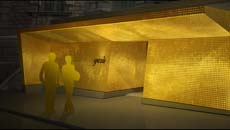A competition on the intangible
by Jacques Lachapelle, published 2009-09-01

Initiated by the Creativity Center of Gesù in partnership with the entertainment district and Design Montreal, this competition of ideas held in 2008 provided a central challenge for both competitors as well as for the jury: lighting in architecture. Specifically, the artifice of light. It is true that initially the project meets a need: nestled in the shadow of Bleury Street, the Creativity Center of Gesù lacks visibility. It needs a signal to affirm its presence. The pretext was to undertake a rich theme, linking religion and performance, from which the submitted projects were inspired. From the performance, the image of the lights from the projectors, and the stagings. From the church, the shadow of its incomplete nature or the desire to help read its architecture. Of religion, rarely mentioned, the divine light! But these thematic pillars that have nourished the majority of projects have brought about risks: the intangibility, the invasiveness of a sophisticated mechanism to provide lighting, the escalation of a mercantile vision at the expense of the religious character, or, for some, forgetting that light does not exist unless it caresses or hits matter.
This remarkable imaginary potential largely explains the success of this competition, 37 submissions on an international scale for, after all, a small project. We must also highlight the importance of the project manager, the Creativity Center of Gesù, which has recognized in the form of a competition of ideas, open to all, without restriction, a way of asserting its own mission: artistic exploration. Moreover, this experience demonstrates the collective value of competitions. By exhibiting projects, and submitting them to a popular vote and by presenting the choices of the jury within a forum, the competition has become an event space that restores dialogue and action regarding the question of public architecture. The formula, already used by Design Montreal on other occasions and adeptly conducted, has revealed once again the richness of this transparent process, which is opposite to the opacity of the majority of large public projects that avoid giving rise to competitions. The light of this modest competition is also there.
(translated by Carmela Cucuzzella)
This remarkable imaginary potential largely explains the success of this competition, 37 submissions on an international scale for, after all, a small project. We must also highlight the importance of the project manager, the Creativity Center of Gesù, which has recognized in the form of a competition of ideas, open to all, without restriction, a way of asserting its own mission: artistic exploration. Moreover, this experience demonstrates the collective value of competitions. By exhibiting projects, and submitting them to a popular vote and by presenting the choices of the jury within a forum, the competition has become an event space that restores dialogue and action regarding the question of public architecture. The formula, already used by Design Montreal on other occasions and adeptly conducted, has revealed once again the richness of this transparent process, which is opposite to the opacity of the majority of large public projects that avoid giving rise to competitions. The light of this modest competition is also there.
(translated by Carmela Cucuzzella)














